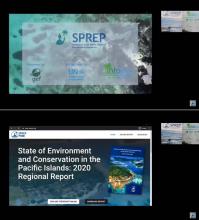Ecological restoration of Socorro Island, Revillagigedo Archipelago, Mexico: the eradication of feral sheep and cats.

Island and Ocean Ecosystems
Available Online
Aguirre-Muñoz, A.
,
Benavides-Ríos, E.
,
Hall, S.
,
Méndez-Sánchez, F.
,
Nevins, H.
,
Ortega-Rubio, A.
,
Ortiz-Alcaraz, A.
,
Rojas-Mayoral, B.
,
Rojas-Mayoral, E.
,
Solís-Carlos, F.
2019
Socorro Island is part of the Revillagigedo National Park, Mexico. At 132 km2, it is the Mexican island with the highest level of endemism. It provides habitat for 117 vascular plant species, 26% of which are endemic. There is also an endemic blue lizard (Urosaurus auriculatus) and eight endemic terrestrial birds. Socorros ecosystem had been heavily degraded by invasive mammals for the past 140 years. Feral sheep (Ovis aries) destroyed one third of the islands habitat and feral cats (Felis catus) severely impacted the islands avifauna and the Socorro blue lizard. Together, feral sheep and cats are responsible for the extinction in the wild of the Socorro dove (Zenaida graysoni) and the Socorro elf owl (Micrathene whitneyi graysoni) and have been a serious threat to other vulnerable species, particularly Townsends shearwater (Pu?nus auricularis). As such, the islands restoration is a high priority. We conducted a feral sheep eradication from 2009 to 2012, using aerial and terrestrial methods, aided by Judas sheep and trained dogs, to kill 1,762 animals. The vegetation recovery has been remarkable, as well as the improvement of soil properties such as compaction, nitrogen, organic carbon, phosphorus, and calcium. In 2011, we initiated a feral cat control programme, which soon became an eradication project. The ongoing feral cat eradication has been a challenge, due to Socorros large size, vegetation and topographical complexity. By December 2016, 502 cats had been dispatched, using soft leg-hold traps equipped with telemetry transmitters and lethal traps: a total e? ort of 50,000 trap-nights. Cat abundance has decreased very signi?cantly and catch per unit of e? ort indicates that the eradication is nearing completion. The abundance of the Socorro blue lizard and terrestrial birds has already increased. We estimate completing the feral cat eradication by the end of 2017, when we will shift to a veri?cation of eradication phase.

